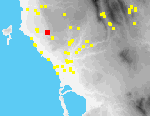 M05 Gargaliani Analipsi
M05 Gargaliani Analipsi
Ca. 1.5 km. SSW of the center of Gargaliani lies a modern church of Ayios Padteleïmon. For ca. 600 m. N of this church along a steep bedrock scarp there are various rock cut features, including small niches carved into vertical bedrock[099.20], regularly cut chambers[098.32], a church built into a modified cave[099.06], and some sections of quarries similar to those preserved on top of the scarp S of Gargaliani. The site, as defined by distribution of artifacts, extends to the plateau above these various architectural features, and down the slopes, ca. 150 m. below and to the W of the scarp.
Architectural features associated with the site include a church and storage facilities built into the scarp ca. 400 m. N of Ay. Padteleïmon. The single-aisled, vaulted church (interior dims. 13 x 5 m.) employs a naturally formed cave and is completed by walls formed of well cut limestone[099.29]. It is entered through a door on the S wall and a there is a single window on the W side. The S and N sides of the interior are lined with benches cut from the bedrock and the E wall terminates in a wide apse lined with a wall[098.25]. Within the church the northern pier of the templon screen, cut from the bedrock, is preserved. Adjacent to this feature, there is a recessed prothesis table and niche. Cuttings into the surrounding stone suggest the former existence of a moulding that would crown this niche. Traces of plaster (possibly painted) were observed in the SW corner of the nave[098.28] at the point where the vault springs from the S wall. To the S of the church is a small recessed storage area with remains of a tile-lined storage bin. The predominance of Byz and Turk material in the area probably suggests a date for the construction and use of the church.
Several other structures in this area employ natural cavities in the limestone scarp, chiefly to the S of the rock-cut church. These structures incude pens for livestock, some of which are enlarged by the construction of fieldstone walls. One notable feature was a number of small niches cut into the limestone ca. 50 m. N of Ay. Padteleïmon, perhaps comparable to cut niches at other sites used for local shrines[099.20].
A limestone statue base with carved mouldings was observed ca. 150 m. NW of the rock-cut church[099.10] and a HL coin[288.06][288.08] ca. 200 m. SW of it.
Material from this site was studied in the field; it dates from the Roman through Byzantine periods. Particularly well-represented, however, are sherds from the Byzantine and Turkish periods. These material remains may correspond in date to the main architectural feature of this site, the rock-cut church of St. Panteleimon. Byzantine sherds were found [in I95-166, 169, 170, 173, 174, 177, 199 and in contiguous tracts 68, 79, 80]. Few sherds from the Roman period were observed [in tract M94-80]. Turkish and Early Modern sherds were noted in all tracts. Pottery was fairly well preserved and representative types included table wares, cookpot fragments and storage vessel handles.